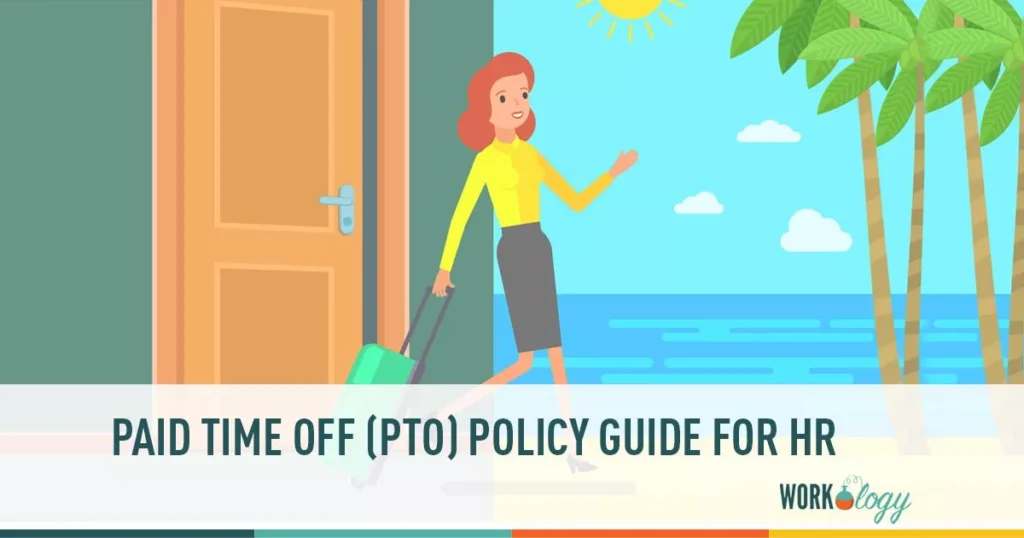Paid time off (or PTO) is a benefit given to employees which allows them to take time off from work while being compensated. Employees can use PTO for sick time, mental health days, jury duty, doctor’s appointments, or any other private matter that necessitates a day off.
PTO isn’t required by law for private businesses, but most understand that good prospective employees will expect and require PTO to thrive in the workplace.
How is PTO different from Vacation Time?
There are many types of paid leave that HR should know about and PTO is one of them. Some companies use PTO as a catch-all for vacations, sick time, and personal days, but other companies have vacation time listed separately since vacation time is longer and meant to be a break from work. Vacation time also usually accrues differently than PTO.
Accrued PTO
PTO is usually given in two ways, and both are used often.
The first way employees can gain PTO is by using an accrual system, where employees get PTO that is accrued hourly, daily, weekly, monthly, or even yearly. Employers often already have a cap on the number of PTO hours or days that employees can use each year and find the best way to distribute the PTO throughout the year.
It’s up to the employer whether accrued hours will roll over into the next year. If not, sometimes companies will pay out the hours as a bonus to the employees. If the PTO doesn’t roll over, sometimes companies will need a negative PTO system at the beginning of the year if employees haven’t accrued PTO yet. So, if an employee has an unmovable doctor’s appointment at the beginning of the year, they can take the day off and pay the debt later. Some companies even have a policy where employees can buy or sell accrued PTO hours.
With this method, employees have to manage their PTO hours carefully, making sure to save up for those appointments that matter and keep sick and mental health days to a minimum. Although some companies do have a separate sick time bank for employees, so they don’t have to sacrifice important appointments in case they get sick.
Unlimited PTO
The second way employees can gain PTO is just…by having it whenever they need it. Unlimited PTO is an attractive concept to many prospective employees. It has gained a lot of attention recently and is common nowadays. However, it’s not as simple as it sounds.
It seems like a no-brainer for employees since they would have as much time as they want–provided they get their work done. Employees would have more time to focus on health, hobbies, and family. It also forms a bond of trust between the employees and the company since the company is giving them free rein to do whatever they think is best. It has some benefits to employers, as well. Using unlimited PTO means they wouldn’t have to pay back unused hours when an employee leaves.
However, unlimited PTO does have some downsides. When employers don’t manage how much or how little employees use PTO, it can be misused – in both directions. An employee could abuse the policy by taking several weeks of vacation constantly. Employees could also be scared of mistakenly abusing the policy, causing them to take less time off and overwork themselves. This second case means that unlimited PTO results in less PTO being taken than with an accrual plan–and they can’t get it back at the end of the year since it was unlimited.
Because of this, companies using an unlimited PTO policy sometimes have conditions that go along with the policy, making it seem “flexible” rather than “unlimited.”
Sample Policies
It’s always better to see some examples, so you can see how these policies will look in your employees’ handbooks.
Here’s an example of an accrued PTO policy:
All full-time employees are eligible to receive Paid Time Off (PTO), provided they work more than 35 hours per week. PTO hours begin accruing upon hire. Employees accrue one hour of PTO for every 10 hours worked or one day of PTO per two weeks.
PTO is disbursed biweekly and must be used before the end of the calendar year. The remaining PTO hours will be paid out to employees at the end of the year.
Employees must provide at least one hour’s notice before their shift begins and notify their shift manager.
Here’s an example of an unlimited PTO policy:
All full-time employees are eligible for our Unlimited Paid Time Off (PTO) policy. Employees are free to take days off when they require it. Employees are required to communicate their days off with their supervisors before the start of the workday.
Employees are still required to meet all work goals and cannot take so much time off that it negatively impacts their work or the company. Employees abusing this system may be subject to disciplinary action.
If staffing needs arise, supervisors may reject PTO requests if too many similar PTO requests have come in simultaneously.
Companies who have both Accrued and Unlimited PTO
Some companies use both accrued and unlimited PTO at the same time.
General Motors, for example, has accruing PTO, giving their employees 15 days per year, which can increase. However, they have unlimited sick time.
Alliant Credit Union offers between 21 and 31 days of PTO and has unlimited time off for their senior managers and higher-level employees.
Salesforce offers 15 days of PTO. After two years, employees can get a month of PTO, and higher-level employees have unlimited vacation days.









